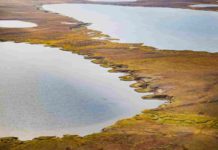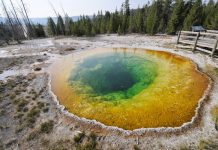
Extreme global warming 252 million years ago caused a severe mass extinction of life on Earth. It took life up to 9 million years to recover. New study finds clues in the Arctic as to why this recovery took so long.
96 percent of marine species, and 70 percent of terrestrial life died off in the Permian-Triassic extinction event, as geologists know it. It is also known as The Great Dying Event for obvious reasons.
“The mass extinction was likely triggered by a explosive event of volcanic eruptions in what is now Siberia. These eruptions lasted for a million years and emitted enormous amounts of volatiles, such as carbon dioxide and methane, which made our planet unbearably hot.” says Jochen Knies, researcher at Centre for Arctic Gas Hydrate, Environment and Climate at UiT The Arctic University of Tromsø.
Life took an extraordinary amount of time to recover from this extinction, from 5 to 9 million years. Why recovery was so delayed, has remained a mystery.
Clues are in the Arctic
Knies is the co-author of a study in Geology that took to the Arctic to look for clues as to what limited return of life to world´s oceans. The results of the study illustrate potential long-term impacts on marine ecosystems in response to global warming.
“What used to be the northwestern continental margin of the supercontinent Pangaea is now Canadian High Arctic. There we found evidence in geological records for a significant nutrient gap during this period. This means that global oceans were severely poor in nutrients such as nitrogen,” says Knies.
This nutrient gap is most likely the result of extremely high ocean surface temperatures in the aftermath of the extinction.
Be cool — stay alive
Our oceans are not a single body of water. They are comprised of layers and boundaries based on temperature (thermocline) and nutrients (nutricline) among others.
“The high temperatures caused deepening of the thermocline and nutricline in the ocean so that upwelling of nutrients from the bottom to the surface of ocean ceased. With that the marine algae productivity was stalled,” according to Knies.
And without algae, which are the base of the food chain, the life in the ocean did not thrive.
Once oceans finally started cooling 6-7 million years after the extinction, nutrient rich waters returned.
“The boundaries that kept the nutrients from reaching the surface were weakened and the ocean waters were mixed. This caused the upwelling of nutrients, resuscitating the oceans, and leading to an explosion of life. The ecosystem voids created by the worst mass extinction in Earth history were finally filled.” states Jochen Knies.
In many ways the Permian-Triassic mass extinction reset the evolution of life, and paved the way for evolution of dinosaurs. They, in turn, died off in another mass extinction 66 million years ago. Today some scientists argue that we are facing a new mass extinction period, mostly caused by human activities.
Reference:
Stephen E. Grasby, Benoit Beauchamp, Jochen Knies. Early Triassic productivity crises delayed recovery from world’s worst mass extinction. Geology, 2016; 44 (9): 779 DOI: 10.1130/G38141.1
Note: The above post is reprinted from materials provided by University of Tromso (Universitetet i Tromsø – UiT).










